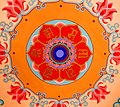Ranjana script
| Rañjanā | |
|---|---|
 'Ranjana Lipi' in Ranjana script | |
| Script type | |
Time period | c. 1100–present |
| Direction | Left-to-right |
| Region | Nepal and India |
| Languages | Prachalit Bhujimol |
| ISO 15924 | |
| ISO 15924 | Ranj (303), Ranjana |
| Brahmic scripts |
|---|
| The Brahmi script and its descendants |
The Rañjanā script (Lantsa
History
Rañjanā is a
After falling into disuse in the mid-20th century, the script has recently seen an increased use. It is used by many local governments such as those of Kathmandu Metropolitan City, Lalitpur Sub-Metropolitan City, Bhaktapur Municipality, Thimi Municipality, Kirtipur Municipality, Banepa Municipality, in signboards, letter pads, and such. Regular programs are held in the Kathmandu Valley to promote the script and training classes are held to preserve the language. The script is being endorsed by the Nepal Bhasa movement and is used for headings in newspapers and websites.[citation needed] A Nepalese-German project is trying to conserve the manuscripts of Rañjanā script.[7]
Alphabet
Vowels
Consonants
Vowel diacritics
-
Vowel diacritic of Ranjana letter 'ग'.
-
Vowel diacritic of Ranjana letter 'ब'.
-
Vowel diacritic of Ranjana letter 'क'.
The shape of the combining marks indicating the vowels आ ā, ए e, ऐ ai/ē,ओ o, and औ au/ō in Ranjana script take a different form when combined with the eight consonants ख kha, ग ga, n ञ nya, ठ ṭha ण ṇa, थ tha, ध dha or श sha(or where one of these is the first consonant in a combination)[8] (In addition the vertical marks indicating आ ā or ī may take a shorter form when combined with the consonants क ka, ज्ञ ja, or ठ ṭha.)
Numerals
Use
-
'Om' in Ranjana script
-
Rañjanā "Oṃ" syllables flanking the implements of the Four Heavenly Kings. Jing'an Temple, Shanghai, China.
-
Sanskrit manuscript in the Rañjanā script. Aṣṭasāhasrikā Prajñāpāramitā Sūtra, India, 12th century.
-
Street sign in Kathmandu in Ranjana, Devanagari and English.
-
Mantra in Rañjanā script, on the ceiling of a Buddhist temple inChina.
Rañjana is mostly used for printing Hindu and Buddhist scriptures and literature in Sanskrit and Buddhist Hybrid Sanskrit used by the
In
Use in Tibet
When Rañjanā was introduced to Tibet, it was referred to as Lantsa (
In Tibet, the Lantsa variant is used to write Buddhist texts in Sanskrit.[19] Examples of such texts include the Mañjuśrīnāmasamgīti, the Diamond Sutra and the Aṣṭasāhasrikā Prajñāpāramitā Sūtra. The Lantsa script is also found in manuscripts and printed editions of some Sanskrit-Tibetan lexicons such as the Mahāvyutpatti. and it is frequently used on the title pages of Tibetan texts, where the Sanskrit title is often written in Lantsa, followed by a transliteration and translation in the Tibetan script. The script is also used to prepare Mantra and Dharani inserted into Buddhist images and Stupa for consecration, as well as in the drawing of certain mandalas ( similar to the Japanese use of the Siddhaṃ script).
Lantsa is frequently seen on the outside of prayer wheels, and decoratively on the gateways, walls. beams and pillars of Tibetan temples and monasteries.
Numerous alternative spellings of the term Lantsa exist, including the following:
- Lanja
- Landzha
- Lantsha
- Lentsa
- Lendza
Monogram (Kutākshar)

Kutākshar is a monogram of the Ranjana script. It is only one of the Nepalese scripts that can be written in monogram.
Unicode
A Unicode block for the script has been proposed by Evertype.[20]
Gallery
-
Nyingma Tibetan Buddhist temple with decorative use of the Lantsa variant of Rañjanā .
-
The Vajra Guru Mantra in the Lantsa variant of Rañjanā and in the Tibetan script.
-
The Mantra of Tara in the Lantsa variant of Rañjanā and Tibetan script.
-
Invitation card.
-
Sandhya Times daily.
-
Signboard of Kathmandu Metropolitan City Office in Ranjana script (second row).
References
- ^ Masica, Colin (1993). The Indo-Aryan languages. p. 143.
- ^ a b Omniglot[self-published source?]
- ^ a b c Jwajalapa[self-published source?] Archived 2007-03-10 at the Wayback Machine
- ^ Folk tales from the Himalayan kingdom of Nepal: Black rice and other stories, p.47, Kesar Lall, Ratna Pustak Bhandar
- ^ Nepalese Inscriptions in the Rubin Collection
- ^ Nagarjuna Institute: Buddhist Sites of Nepal – Hiraynavarna Mahavihara
- ^ Ranjana Script[self-published source?]
- ISBN 9993334367.
- ^ "Preliminary proposal for encoding the Rañjana script in the SMP of the UCS" (PDF). 2006. 3649.
- ^ [1], Preservation of Sanskrit Buddhist Manuscripts in the Kathmandu Valley: Its importance and future, Min Bahadur Shakya
- ^ Teachings og Buddha[self-published source?]
- ^ Dharma Haven[self-published source?]
- ^ Ranjana font[self-published source?]
- ^ Asian art
- ^ Chattopadhayaya, Alaka (1999). Atisa and Tibet: Life and Works of Dipamkara Srijnana: p. 201
- ^ Jiang, Wu (2008). Enlightenment in Dispute: The Reinvention of Chan Buddhism in Seventeenth-Century China: p. 146
- ^ "Ma Phương :: Tinh Hoa Đông Phương". maphuong.com. Retrieved 2021-08-24.
- ^ "lany+dza". Dharma Dictionary. Tsadra Foundation. Retrieved 2022-03-19.
- ^ Ranjana script and Nepal Bhasa (Newari) language
- ^ Preliminary proposal for encoding the Rañjana script in the SMP of the UCS
External links
- Download Ranjana Newari Regular Font
- Everson, Michael (2009). "Preliminary proposal for encoding the Rañjana script in the SMP of the UCS" (PDF). n3649.
- Everson, Michael (2009). "Roadmapping the scripts of Nepal" (PDF). n3692.
- Fynn, Christopher John. Ranjana (Lantsa) script
- Pandey, Anshuman (2016). "Towards an encoding for the Ranjana and Lantsa scripts" (PDF). L2/L2016/16015.
- Ranjana script on Omniglot
- Ranjana script
- Saerji. (2009). Rañjanā script: Akṣara List of the Manuscript of Aṣṭasāhasrikāprajñāpāramitā (ca. the 11–12th Centuries). Research Institute of Sanskrit Manuscripts & Buddhist Literature, Peking University.













